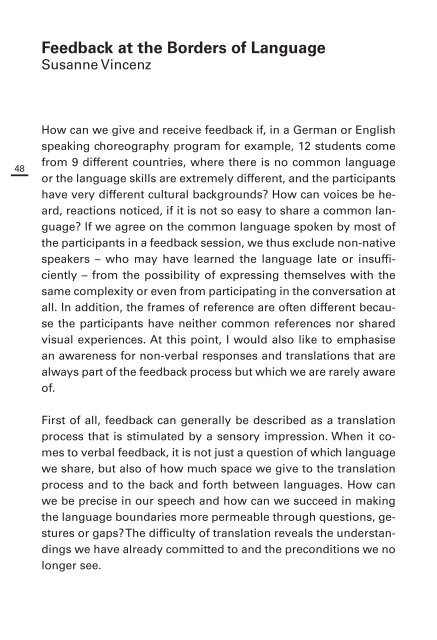Laboratory on Feedback in Artistic Processes 3
In its third edition the "Laboratory on Feedback in Artistic Processes" reflects on "Responses" within performing arts. The results of the previous Labs highlighted the need to take a closer look at the complexity and often subtle implications of feedback within the the artistic process itself. How do artist organise feedback and how do they process it? Who they want feedback from and what are its different roles? How can describe these relationships, and how does it shpae the artistic work? This booklet presents the different views on and experiences of feedback practices that were elaborated during the lab along the beforementioned questions and the insightfull contributions of its participants. Underpinning the following pages, three thematic fields have emerged: the impacts of feedback, feedback as a tool, and practicalities and contexts of feedback.
In its third edition the "Laboratory on Feedback in Artistic Processes" reflects on "Responses" within performing arts. The results of the previous Labs highlighted the need to take a closer look at the complexity and often subtle implications of feedback within the the artistic process itself. How do artist organise feedback and how do they process it? Who they want feedback from and what are its different roles? How can describe these relationships, and how does it shpae the artistic work?
This booklet presents the different views on and experiences of feedback practices that were elaborated during the lab along the beforementioned questions and the insightfull contributions of its participants. Underpinning the following pages, three thematic fields have emerged: the impacts of feedback, feedback as a tool, and practicalities and contexts of feedback.
You also want an ePaper? Increase the reach of your titles
YUMPU automatically turns print PDFs into web optimized ePapers that Google loves.
<strong>Feedback</strong> at the Borders of Language<br />
Susanne V<strong>in</strong>cenz<br />
48<br />
How can we give and receive feedback if, <strong>in</strong> a German or English<br />
speak<strong>in</strong>g choreography program for example, 12 students come<br />
from 9 different countries, where there is no comm<strong>on</strong> language<br />
or the language skills are extremely different, and the participants<br />
have very different cultural backgrounds? How can voices be heard,<br />
reacti<strong>on</strong>s noticed, if it is not so easy to share a comm<strong>on</strong> language?<br />
If we agree <strong>on</strong> the comm<strong>on</strong> language spoken by most of<br />
the participants <strong>in</strong> a feedback sessi<strong>on</strong>, we thus exclude n<strong>on</strong>-native<br />
speakers – who may have learned the language late or <strong>in</strong>sufficiently<br />
– from the possibility of express<strong>in</strong>g themselves with the<br />
same complexity or even from participat<strong>in</strong>g <strong>in</strong> the c<strong>on</strong>versati<strong>on</strong> at<br />
all. In additi<strong>on</strong>, the frames of reference are often different because<br />
the participants have neither comm<strong>on</strong> references nor shared<br />
visual experiences. At this po<strong>in</strong>t, I would also like to emphasise<br />
an awareness for n<strong>on</strong>-verbal resp<strong>on</strong>ses and translati<strong>on</strong>s that are<br />
always part of the feedback process but which we are rarely aware<br />
of.<br />
First of all, feedback can generally be described as a translati<strong>on</strong><br />
process that is stimulated by a sensory impressi<strong>on</strong>. When it comes<br />
to verbal feedback, it is not just a questi<strong>on</strong> of which language<br />
we share, but also of how much space we give to the translati<strong>on</strong><br />
process and to the back and forth between languages. How can<br />
we be precise <strong>in</strong> our speech and how can we succeed <strong>in</strong> mak<strong>in</strong>g<br />
the language boundaries more permeable through questi<strong>on</strong>s, gestures<br />
or gaps? The difficulty of translati<strong>on</strong> reveals the understand<strong>in</strong>gs<br />
we have already committed to and the prec<strong>on</strong>diti<strong>on</strong>s we no<br />
l<strong>on</strong>ger see.


















